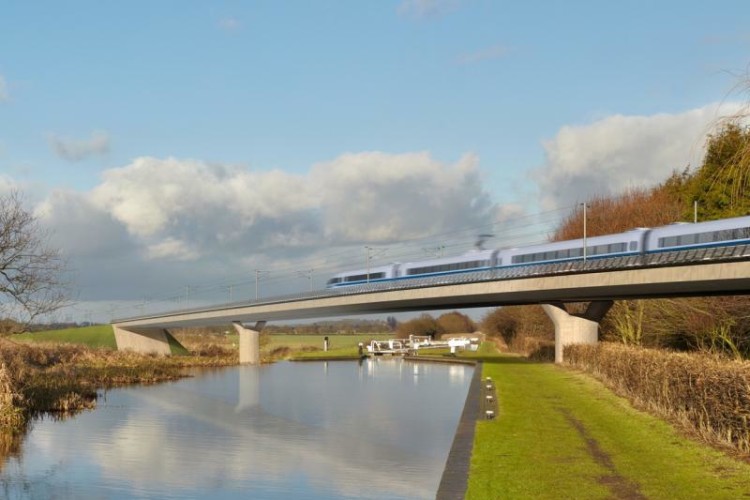In a damning review of High Speed 2 planning, the National Audit Office says that the government has twice got its numbers wrong and not yet made the case that the extra rail capacity is needed.
The report out today, titled High Speed 2: A review of early programme preparation*, says that “the strategic case for HS2, in terms of increasing rail capacity and generating regional growth, has still to be demonstrated clearly”.
In presenting its case for investment in the project, the Department for Transport (DfT) is said to have poorly articulated the strategic need for a transformation in rail capacity and how HS2 will help generate regional economic growth.
The report notes that the estimated cost of phase one will change as costs become firmer. In some documents, the estimated cost is between £15.4bn and £17.3bn but a new estimate is being developed based on a clearer route and more information. The NAO estimates that there is a £3.3bn funding gap over four years (2017-18 to 2020-21) which the government has yet to decide how to fill.
According to today’s report, the methodology used for appraising the project puts a high emphasis on journey-time savings, from faster and more reliable journeys. However, the relationship between these savings and the strategic reasons for doing the project, such as rebalancing regional economies, is unclear.
It is also unclear to the NAO whether the business case covers just the route between London and the West Midlands (phase one, due to open in 2026) or the full Y-shaped network with lines from Birmingham to Manchester and Leeds respectively (phase two, due to open in 2032). The Y-network has a stronger economic case but this is much less certain as route designs are less well-developed.
The benefit-cost ratio calculated for phase one has twice contained errors, the NAO says, and the DfT has been slow to carry out its own assurance of the underlying analysis. The NAO’s opinion is that the DfT and the developer company HS2 Ltd should update the data underpinning some key assumptions in the ratio.
The most recent benefit-cost ratio (published in August 2012) is 1.4 to 1 but is likely to change. This to be expected, the NAO acknowledges, as the ratio is sensitive to changes in data underpinning assumptions, such as GDP growth forecasts. It does not, however, reflect the DfT’s current assumption on the relationship between passenger numbers and GDP growth. The DfT now expects passenger numbers to grow more slowly when GDP increases. There are also questions about how transport economists assess the value of shorter journey times, given that today’s business travellers with mobile devices are better able to be productive while on the move. The NAO says that there should be more research on how business travellers use their time on trains.
HS2 Ltd has also not yet analysed the effect on passenger demand, revenues and the benefit-cost ratio of charging passengers premium prices, NAO says.
Amyas Morse, head of the National Audit Office, said: “It’s too early in the High Speed 2 programme to conclude on the likelihood of its achieving value for money. Our concern at this point is the lack of clarity around the department’s objectives. The strategic case for the network should be better developed at this stage of the programme. It is intended to demonstrate the need for the line but so far presents limited evidence on forecast passenger demand and expected capacity shortages on existing lines. It is also unclear how High Speed 2 will transform regional economies by delivering jobs and growth. The department is trying against a challenging timetable to strengthen its evidence and analysis, which at present provide a weak foundation for securing and demonstrating success in the programme in future."

* The full report can be found at http://www.nao.org.uk/wp-content/uploads/2013/05/Full-Report.pdf
Industry reaction
CBI director of business environment Rhian Kelly said: “It is early days in a 20-year project but the government needs to implement lessons quickly from last year's franchising failure to make HS2 a success. Industry, investors and taxpayers must see a watertight business case and programme management.
“There is very little advantage in prolonging the timetable given the West Coast Main Line is set to reach full capacity by the mid-2020s - squeezing out passengers and freight. Ministers need to secure real consensus on the route now to avoid the project being hit by years of delays further d own the line.
“HS2 cannot be built in isolation. We need sustained, additional capital investment in existing road and rail networks now to meet increased demand.”
HS2 in numbers
£15.4bn to £17.3bn: Estimate of the capital cost of constructing phase one.
2026: Phase one, between London and the West Midlands, is due to open.
1.4 to 1: The most recent transport benefit–cost ratio for phase one, published in August 2012.
2.5 to 1: August 2012 benefit–cost ratio for the Y-shaped network, from London to the West Midlands, Manchester and Leeds, when wider economic impacts are also included. For phase one this ratio is 1.7 to 1.
£3.3 billion: Amount to be found by government spread over the four peak years of construction of phase one (2017-18 to 2020-21) to cover the gap between the Department's forecast capital spending and its capital budgets if these were kept at 2014-15 levels.
Got a story? Email news@theconstructionindex.co.uk



